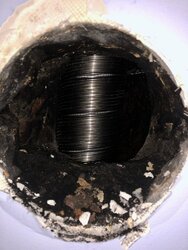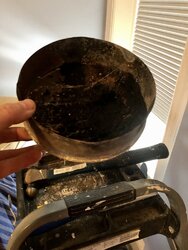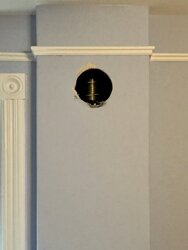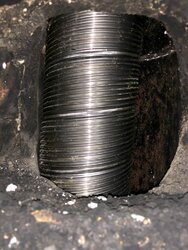Hello!
I’ve been burning for just over a week. This is a wood stove retrofit into an existing chimney in an 1880s home in Ontario Canada. The stove is an Ashford 30. Chimney is 45’ from the ground or about 35-37’ from the top of the stove.
This was lined with an uninsulated stainless liner. Drafts like a boss. Masonry gets about 4-5c hotter on the surface of the chimney on the second floor above the stove.
The house is triple brick construction. The chimney bumps towards the inside of the house rather than out. It’s about a brick and half width into the house (maybe a touch more). The clay flue liner is 9” round (so I guess about 7” or so interior, maybe a touch more). It is mortared into the center of the chimney. They actually cut bricks all the way up to hold that flue in nice and tight.
I was doing a routine check of of the inside bricks and found a hotspot in a second bedroom close to the chimney. I shut the stove down, and today i took a chisel to the spot and found a rusty steel cap, and hehind that a pile of old soot, an opening into the flue and my liner. Probably a parlor stove from way back.
I could brick this up fairly easily but I’m concerned this may not be the entire solution.
Thoughts?
I’ve been burning for just over a week. This is a wood stove retrofit into an existing chimney in an 1880s home in Ontario Canada. The stove is an Ashford 30. Chimney is 45’ from the ground or about 35-37’ from the top of the stove.
This was lined with an uninsulated stainless liner. Drafts like a boss. Masonry gets about 4-5c hotter on the surface of the chimney on the second floor above the stove.
The house is triple brick construction. The chimney bumps towards the inside of the house rather than out. It’s about a brick and half width into the house (maybe a touch more). The clay flue liner is 9” round (so I guess about 7” or so interior, maybe a touch more). It is mortared into the center of the chimney. They actually cut bricks all the way up to hold that flue in nice and tight.
I was doing a routine check of of the inside bricks and found a hotspot in a second bedroom close to the chimney. I shut the stove down, and today i took a chisel to the spot and found a rusty steel cap, and hehind that a pile of old soot, an opening into the flue and my liner. Probably a parlor stove from way back.
I could brick this up fairly easily but I’m concerned this may not be the entire solution.
Thoughts?





